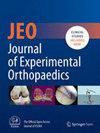The central fibre areas in the tibial footprint of the posterior cruciate ligament show the highest contribution to restriction of a posterior drawer force—A biomechanical robotic investigation
Abstract
Purpose
The purpose of this study was to determine the role of different fibre areas of the tibial footprint of the posterior cruciate ligament (PCL) in restraining posterior tibial translation.
Methods
A sequential cutting study on cadaveric knee specimens (n = 8) was performed, utilizing a six-degrees-of-freedom robotic test setup. The tibial attachment of the PCL was divided into nine areas, which were sequentially cut in a randomized sequence. After determining the native knee kinematics with 89 N anterior, and posterior tibial translation force at 0°, 30°, 60° and 90° knee flexion, a displacement-controlled protocol was performed replaying the native motion. Utilizing the principle of superposition, the reduction of the restraining force represents the contribution (in-situ forces) of each cut fibre area.
Results
The PCL was found to contribute 25.3 ± 11.1% in 0° of flexion, 49.7 ± 19.2% in 30° of flexion, 58.9 ± 19.3% in 60° of flexion and 50.6 ± 15.1% in 90° of flexion, to the restriction of a posterior drawer force. Depending on the flexion angle, every cut area of the tibial PCL footprint was shown to be a significant restrictor of posterior tibial translation (p ≤ 0.05). When investigating the fibre areas from anterior to posterior, the central fibre areas showed the highest contribution (35.0%–44.3%). When investigating the fibre areas from medial to lateral, the lateral fibre areas showed the highest contribution (41.4%–43.6%) from 0 to 30° knee flexion, while the medial fibre areas showed the highest contribution (41.5%) in 90° knee flexion.
Conclusion
The central row areas in the tibial footprint of the PCL were identified to be the main contributors inside the tibial footprint, while, depending on the flexion angle, the medial or lateral column fibre areas showed a higher contribution. These findings might inform the clinician to place a PCL graft centrally into the tibial footprint during reconstruction.
Level of Evidence
Not applicable.


 求助内容:
求助内容: 应助结果提醒方式:
应助结果提醒方式:


